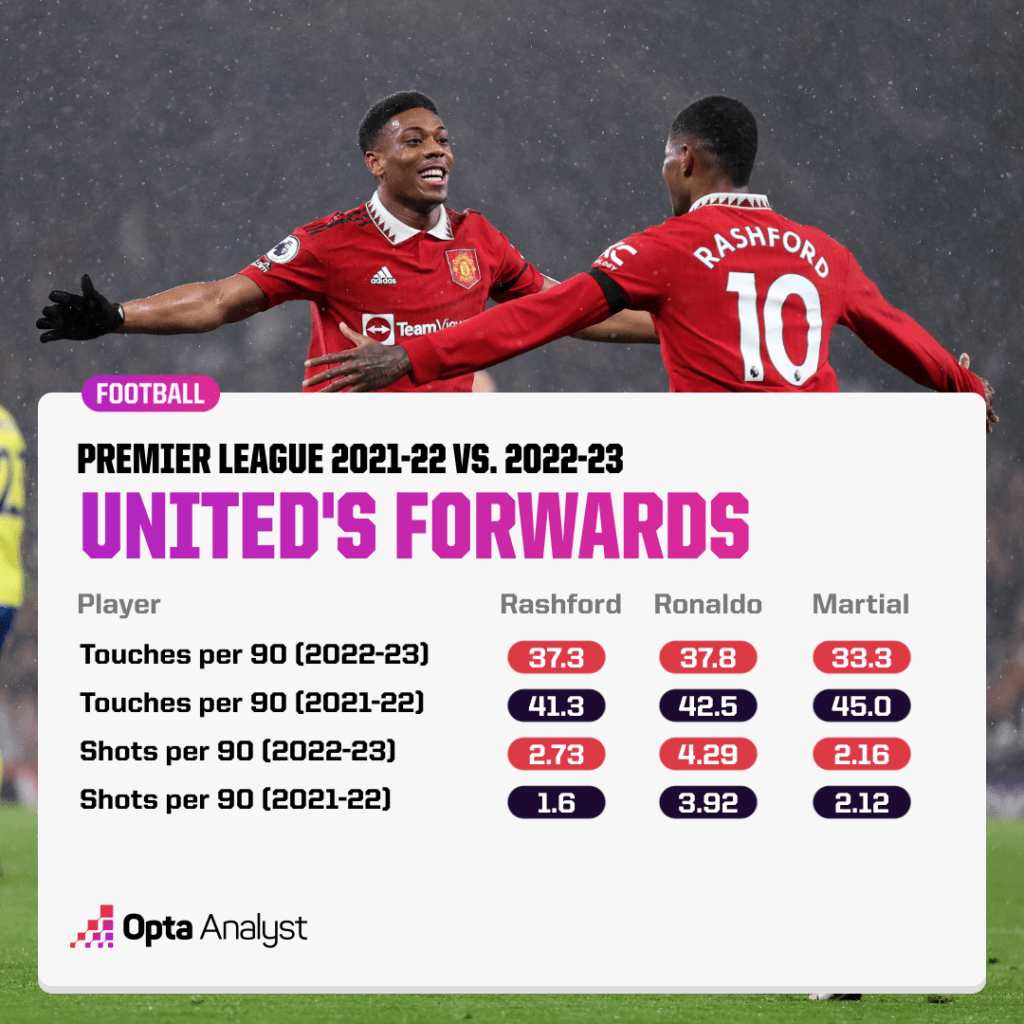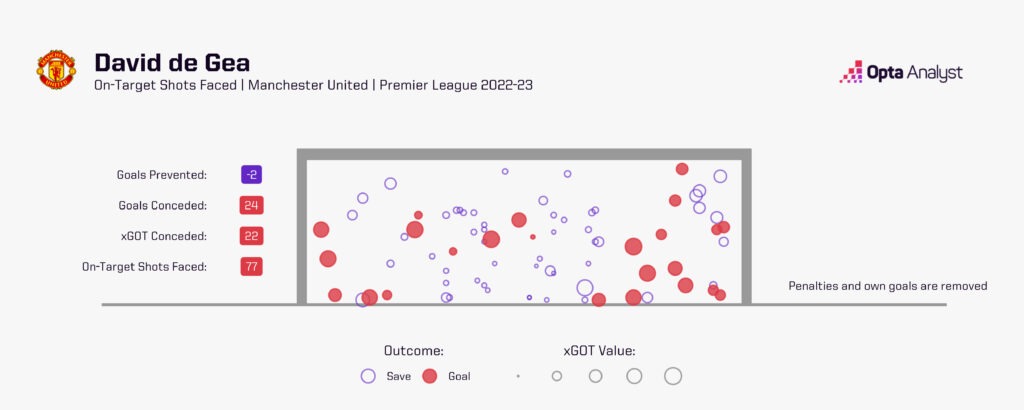The 4-0 thumping by Brentford in August, making it two defeats from two for Erik ten Hag, confirmed the worst: many viewed Manchester United as a mess, a club so hampered by mismanagement their trajectory was set to mimic Liverpool’s three-decade ramble in the wilderness.
Football is stimulated by our collectively short memory, which is no bad thing – it fuels the churn of crises and new dawns that make up our Premier League life. But the faster the change the less we remember, which is an irritating habit that tends to erase the past and deny people their due credit.
When that happens it’s worth diving into our sense memories for some perspective. Remember how awful that 4-0 defeat was? How lost Man Utd were, how irrefutable the argument that Ten Hag would struggle to turn things around?
Since that day he has done an unbelievable job, far exceeding what anyone anticipated in year one of the rebuild. A lot of that is down to his charisma and control of the dressing room, his firm hand and intelligent leadership. Even more important, perhaps, has been the influence of Casemiro and Christian Eriksen in midfield and the simple individual quality that has won the ‘moments’ in even games.
What is talked about far less are the tactical principles he has gradually introduced, a factor that rarely gets media coverage until the core ideas are staring pundits in the face. But Opta data shows us they are beginning to take shape.
Direct, Progressive Creativity Is Forming
Before we dive in, it’s worth briefly summarising Ten Hag’s tactics and what we should be looking for. In broad terms, his Ajax team were about purposeful possession: Guardiola-like control with extremely detailed coaching of where players should position themselves, but with a greater emphasis on verticality and direct running in the final third. Ten Hag seeks to press from the front and pen teams in, but when building from the back wants to draw the opponent forward before breaking quickly into the spaces left behind.
Ten Hag even highlighted this in his press conference after the defeat to Brentford:
“It’s naive, how we played today, you have to play more direct. We said: invite them in [to press] and play long. We attracted them, the space was high on the pitch and we had to choose that option. That’s what we couldn’t do.”
So let’s start here, with the vertical stuff. The headline is that Man Utd are moving well in the forward line but are not quite operating consistently enough at this juncture.
They are top of the charts for total number of direct attacks – essentially a proxy for counter attacks – by a considerable distance. They’ve recorded 51 so far, which is 25% more than second-placed Tottenham Hotspur, Fulham, and Liverpool (38). This is noticeable to the naked eye when witnessing Marcus Rashford and Anthony Martial making runs on the shoulder of the last defender, often switching positions as they dart from out to in. That’s why United are joint top for total through balls played, with 48.
Further evidence can be found in the number of touches taken by their forwards. As the table below shows, United’s three most used forwards this season (who were also at the club in 2021-22) are taking fewer touches this year compared to last yet are recording better shot-per-game averages. Fewer touches does not mean less involvement in the action, but rather a different way of playing: they come short less, making runs to feed a more direct approach.
But Possession Football Still a Little Sideways…
So, Manchester United are getting better at playing vertically through the lines, but clearly they are not yet the finished article: it is telling that they are eighth in the Premier League for progressive passes (556), some way off the standard set by the top clubs. What we see here is a club still occasionally stuck moving sideways as they learn the intricacies of Ten Hag’s positional demands.
They are only eighth in the division for total number of 10+ open-play pass sequences (212), behind even Antonio Conte’s Tottenham, and have only held 60% possession or higher on six occasions in the Premier League – winning a mere two of these games, against Nottingham Forest and Everton.
Ten Hag might not want possession for possession’s sake, but he still wants his team to control the ball for long periods, especially at the back, before suddenly switching the tempo with direct football. Counter-intuitively, you cannot have the latter without the former, as Liverpool have shown over the years, because to attack with verticality at all times would create an amorphous formation that is exposed to opposition counters and end-to-end chaos.
Things are just a little awkward in possession still, which is fair enough given how hard it is to understand a manager’s automatisms working at this level. You can see players making runs in anticipation of receiving the next-but-one pass, and you can see passes being made blind – in expectation of someone being there – which is a good indicator of structured possession. But it is revealing that no team has had more interceptions against them than United’s 227.
Knowing the system has not yet clicked into place, Ten Hag has had success by being more flexible than anticipated, humbly letting go of his principles to embrace the Ole Gunnar Solskjaer methods of deep-lying, counter-attacking football in big matches.
Across five matches against Manchester City, Liverpool, and Arsenal, Man Utd have averaged 38% possession – and won nine points. On each occasion United simply sat back in their own half, refusing to press the opposition and hoping to break in rare opportunities. Across those five games, United have averaged 18.2 PPDA, far higher than their seasonal average of 13.8.
Pressing System Also on the Up
Man Utd’s off-the-ball work follows the same pattern as their vertical possession: they look good when pressing high and hard, but can’t quite do it with enough regularity. These stats are arguably skewed by the five games against the big clubs above, but it is still noteworthy that Man Utd are 13th for total high turnovers with 148, and yet they sit joint-fourth, with 29, for high turnovers that lead to a shot. Again, the misalignment here speaks volumes.
The stats are lopsided across the board. United are 13th for PPDA (13.8) while their total presses is just 473, below even Wolves, despite the fact their average duration of each press (6.76 seconds) puts them fourth and just behind Man City. If that wasn’t confusing enough, they are third in the league for interceptions (202) yet firmly mid-table when it comes to total number of pressures and third bottom when it comes to the average velocity of those pressures (4.2kph).
This may have something to do with their forwards’ ability to press. Ronaldo being gone helps, but Rashford isn’t the best at pressing either; he ranks 13th for pressures applied in the attacking third (145), below the likes of Odsonne Édouard and Che Adams.
A New Goalkeeper and Right-Back the Priorities
Not that United need to upgrade on Rashford, one of the standout performers of Ten Hag’s tenure so far. Instead, they should focus on a new goalkeeper and a new right-back, without which there is a limit on the tactical improvements that can be made.
To build out from the back without making mistakes, drawing the opponent onto them and providing the foundation for possession-dominance followed by sudden verticality, United desperately need a ball-playing goalkeeper.
David de Gea ranks 16th in the Premier League for total number of goalkeeping actions outside the area, with 16, and he is all the way down in 13th for passes attempted (507). Surely Ten Hag would want that figure higher, and with better quality on the ball United would be less likely to lose it in their own third – only six teams suffer more high turnovers than Man Utd’s 106.
The usual argument in favour of De Gea is that what you lose with his (lack of) passing ability, you make up for with his shot-stopping. But by the Spaniard’s lofty standards he’s having a poor season on that front, conceding two goals more than the average goalkeeper would’ve been expected to save based on the quality of shots he’s faced. That’s the 11th best figure in the league of ‘keepers to have played 50% of more available minutes.
A look at Man Utd’s zones of control shows a glaring red light in the right-back area. Aaron Wan-Bissaka has struggled at times this season, making minor positional errors that lead to goals, and yet the attacking side of things is the real problem. Antony has struggled to settle because he needs a better over-lapper to draw attention away, and it has become a running joke among United fans that Wan-Bissaka is unwilling to get forward and cross the ball.
United have crossed the ball fewer times than any other Premier League club (265), even though they top the charts – by a distance – for average number passing options available when they do so (1.85). If they can counter-balance their strength on the left, Man Utd might suddenly find they can be far more vertical and progressive, as well as improve on their possession.
That’s the holy grail for Ten Hag. It is beyond extraordinary that, just five months on from the defeat at Brentford, he might only be a couple of signings away.

